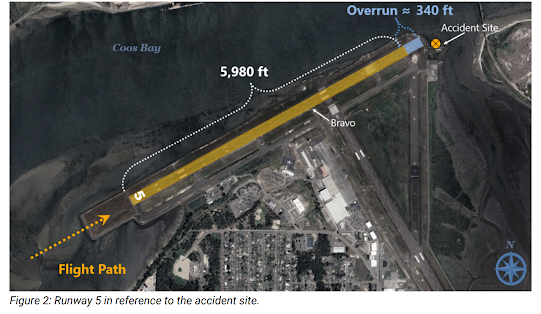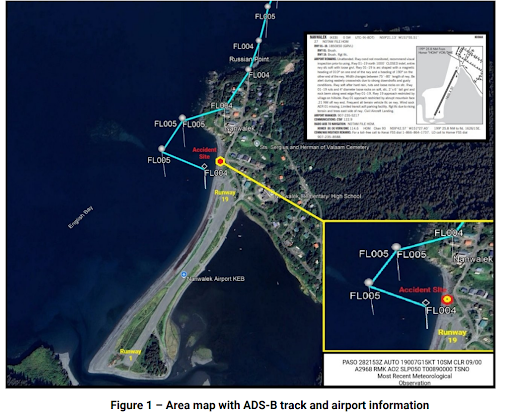This is preliminary information, subject to change, and may contain errors. Any errors in this report will be corrected when the final report has been completed.
Aviation Accident Preliminary Report - National Transportation Safety Board
The National Transportation Safety Board did not travel to the scene of this accident.
Investigator In Charge (IIC): Keliher, Zoe
Additional Participating Entities:
Shawn Kellar; Federal Aviation Administration; Portland, OR
Thomas Sully; Honda Aircraft Company; Greensboro, NC
https://registry.faa.gov/AircraftInquiry/Search/NNumberResult?nNumberTxt=N826E
https://data.ntsb.gov/carol-repgen/api/Aviation/ReportMain/GenerateNewestReport/199972/pdf
Andy Leavitt Enterprises LLC
- Location: North Bend, OR
- Accident Number: WPR25LA124
- Date & Time: April 7, 2025, 06:06 Local
- Registration: N826E
- Aircraft: HONDA AIRCRAFT CO LLC HA-420
- Injuries: 1 Serious, 4 Minor
- Flight Conducted Under: Part 91: General aviation - Executive/Corporate
On April 7, 2025, at 0606 Pacific daylight time, a Honda Aircraft Company HA-420, N826E, was substantially damaged when it was involved in an accident in North Bend, Oregon. The pilot and three passengers sustained minor injuries; one passenger sustained serious injuries. The airplane was being operated as a Title 14 Code of Federal Regulations Part 91 corporate flight.
The airplane departed St. George, Utah, at 0409, on an instrument flight rules flight plan. As he approached the airport, the pilot configured the airplane for landing on the ILS Z approach to runway 5. He had flown this particular approach regularly because every Monday morning for the last year, he flew the same flight around the same time, transporting the operator’s employees from St. George, Utah, to North Bend, Oregon, returning each Friday. The front rightseated passenger, the son-in-law of the airplane’s owner, was a student pilot nearing his certification, but he was not flying the airplane.
The pilot detailed his pre-landing procedures, specifically describing how he determined VREF (calculated reference speed for final approach). He stated that he entered relevant data into the airplane’s Flight Management System (FMS) which included the following data blocks ( the information he stated he enter are in parentheses): runway condition (wet), weather information (11°C), flap settings (full down), runway selection (runway 5), wind information (provided from the airport’s AWOS), and the airplane’s weight (the system calculated by using fuel burn, but he recalled was around 9,000 lbs). The FMS then provided the required landing distance of approximately 4,200 feet, which he thought was well under the runway length.
The pilot recalled that on the day of the accident, the approach was normal and there was a reported crosswind of nine knots. There was limited visibility due to darkness at that time of the morning and he did not specifically observe standing water on the runway but the pilot was aware of recent heavy rainfall. The airplane crossed the runway threshold around 117-118 knots, slightly above the VREF calculated speed of 113 knots, which he configured due to the crosswind. The airplane touched down on the runway surface at approximately 1,000 feet from the approach end near 113 knots, consistent with his typical procedures.
The pilot further stated that the initial braking felt normal, and he anticipated the airplane's deceleration rate would enable him to exit the runway at taxiway Bravo. As the airplane continued the landing roll and was about halfway down the runway, the braking was seemingly ineffective, though there were no warnings or messages. The pilot and right seated passenger then applied maximum brake pressure, but the airplane was not responding. Recognizing the inability to stop, and as the landing roll continued toward the localizer antenna at the end of the runway, the pilot maneuvered the airplane to the right to avoid the structure. The airplane traversed through grass and mud before descending an approximate 15-foot embankment into adjacent water. The occupants exited the airplane through the main door into the shallow salt water.
A review of the ADS-B data showed that at 0606:14, the airplane touched down on the runway near the aiming point markings. The airplane continued down the centerline, decelerating from a ground speed of about 128 knots to 125 knots, which was the last recorded hit (near taxiway Bravo). A visual examination of the runway surface revealed no evidence of skid marks or indications of the anti-skid braking system operating. Light tire tracks were observed on the overrun area and through the grass with no indication of braking. The left tire track was about 23ft from the end of the localizer antenna structure; the distance from the left winglet to the left tire is about 15ft (see figure 1).
Located on the north side of the airport, runway 5 is oriented northeast-southwest and is 5,980 ft long by 150 ft wide (see figure 2). The runway is constructed of grooved asphalt/concrete and has a listed Landing Distance Available (LDA) of 5,320ft, which excludes the 660 ft length of the displaced threshold for runway 23. The overrun area is about 340 ft, followed by about 100 ft of grass and rocks between the end of the pavement and the water.
The airplane had been upgraded with the Honda Aircraft Company Airplane Flight Manual (AFM) Supplement, "Wet and Contaminated Runway Performance" for the HondaJet ELITE S (Revision A, dated July 20, 2023). The logbooks indicated the software had been upgraded in the FMS to reflect the revised AFM. The definition contained in the supplement for “wet runway” is then “water depth on the runway is less than 0.125 inch.”
The VREF and landing distance required were calculated from the AFMS based on the temperature of 11°C, the self-reported weight of 9,000 lbs, a “wet” runway, negligible tail/head wind, a runway slope gradient of 0.05%, and an airport altitude of 16 ft. The AFMS provided a required landing distance of 5,910 ft, and a VREF of 111kts.
The airplane was not equipped with thrust reversers or spoilers. During landing, the speed brake was deployed; the emergency braking system was not used. The initial examination of the wheels and braking system revealed no evidence of failures, excessive wear, or malfunctions. Investigators removed components from the airframe to be tested at a later date.
A preliminary comparison of prior flights and the accident flight was performed (see figure 3). The accident flight was similar to the previous flights, aside from a slightly higher ground speed at touchdown.





